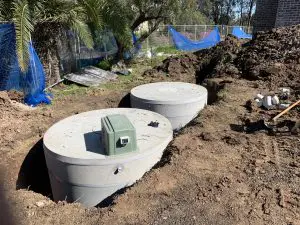What Size Septic Tank Do I Need For My Home?
If you live in a rural area or a place where a municipal sewer system is not available, you may need to install a septic system to treat and dispose of wastewater from your home. A septic system consists of a septic tank and a drainfield, also known as a leach field. The septic tank is an underground container that holds and separates solids and liquids in the wastewater.
If you’re planning to install a septic system for your home, one of the most important factors to consider is the size of the septic tank. A properly sized septic tank will ensure that your system functions efficiently and effectively, while an undersized tank can lead to frequent backups and costly repairs.
Determining the Right Size for Your Septic Tank
The size of your septic tank will depend on several factors, including the size of your home, the number of bedrooms, and the estimated daily wastewater flow. In general, the larger the home and the more bedrooms, the larger the septic tank you’ll need.
The International Association of Plumbing and Mechanical Officials (IAPMO) provides guidance on septic tank sizing based on the number of bedrooms in a home:
</
| Number of Bedrooms | Minimum Tank Size |
|---|---|
| 1-2 | 3000 litres |
| 3 | 4000 litres |
| 4 | 5000 litres |
| 5 | 6000 litres |
| 6 | 7000 litres |
Note that these are minimum requirements, and depending on your household’s daily water usage and other factors, you may need a larger septic tank.
You’ll also need to consider the soil type and drainage characteristics of your property when sizing your septic tank. A soil evaluation by a qualified professional can help determine the absorption rate of the soil and the appropriate size of the drainfield.
Factors that Affect Wastewater Flow
To determine the appropriate size of your septic tank, you’ll need to estimate the daily wastewater flow from your household. This can vary depending on several factors:
- Number of people in the household
- Water usage habits (e.g. long showers, running water while brushing teeth)
- Presence of water-efficient appliances and fixtures (e.g. low-flow toilets, efficient washing machines)
- Frequency of entertaining guests or hosting events
You can use the following table as a rough guide to estimate your household’s daily wastewater flow:
| Fixture or Activity | Average Flow (Litres per Day) |
|---|---|
| Toilet | 3-6 |
| Bath | 20-30 |
| Shower | 20-30 |
| Dishwasher | 4-8 |
| Washing Machine | 20-30 |
| Kitchen Sink | 2-4 |
| Lavatory Sink | 1-2 |
Add up the estimated flow for each fixture or activity to get your household’s total daily wastewater flow. Keep in mind that these are rough estimates, and your actual water usage may vary.
Other Considerations
In addition to the factors mentioned above, there are other considerations to keep in mind when sizing your septic tank:
- Local regulations: Your local health department may have specific requirements for septic tank sizing.
- Future plans: If you plan to add bedrooms or increase your household size in the future, you may need a larger septic tank.
- Maintenance: A larger septic tank
may require less frequent pumping and maintenance than a smaller tank. - Cost: Larger septic tanks typically cost more than smaller tanks, so you’ll need to weigh the cost against the benefits of a larger tank.
It’s also important to choose a reputable septic tank installer who can help you select the appropriate tank size and ensure that it is installed correctly. Improper installation can lead to a variety of problems, including sewage backups and environmental contamination.
Conclusion
Choosing the right size septic tank is an important decision that can have long-term impacts on your home’s wastewater treatment system. By considering factors such as the size of your household, daily water usage, and soil type, you can select a tank that meets your needs and provides reliable, efficient wastewater treatment.
If you’re unsure about the appropriate size for your septic tank, it’s always best to consult with a qualified professional. They can help you assess your household’s needs and determine the appropriate size of septic tank for your property.
Remember that regular maintenance and pumping of your septic tank is also essential to keep it functioning properly. By following best practices for septic tank care and maintenance, you can ensure that your system operates efficiently and effectively for many years to come.
“`
I hope this guide has been helpful in determining the appropriate size septic tank for your home. Remember to consider factors such as household size, daily water usage, and soil type when making your decision. And don’t forget to choose a reputable installer and follow best practices for septic tank care and maintenance to keep your system functioning properly.
Eco-Septic is a Sydney based manufacturer and specialises in commercial wastewater systems of various shapes and designs. We can provide fast and free quotes relevant to your commercial wastewater needs, all while keeping in mind individual spending capabilities
Feel free to contact us on 1800 808 135 to discuss tank/system type, sizing and pricing or visit us at www.ecoseptic.com.au for more information.
We cover all Sydney suburbs as well as the regions of South Coast, Snowy Mountains, Southern Highlands, Riverina, Blue Mountains and Hawkesbury, Laguna, North and Mid North Coast, Bateman’s Bay, Nowra, Mallacoota, Narooma, Balmoral, Cobargo, Glenn Ines, Avondale, Glenmore, Mogo, Tarago, Torrumbarry, Albury, Faulconbridge, Maraylya, Sherbrooke, Strathdickie, Little Hartley, Linden, cattail, Bowen Mountain, Murwillumbah, Kyogle, Bryon Bay, Lismore, Evan Heads, Yamba, Grafton, and surrounding areas.
Related Posts
- Pros and Cons of AWTS for Rural Homes: Is It the Right Choice?
- The Economics of Septic Systems: Cost Savings and Long-Term Investments
- What happens to all the waste that’s pumped from septic tanks?
- Understanding Grey Water Recycling Systems
- Septic Tanks vs. AWTS: Which Is Better for Your Sydney Property?
- What To Consider When Looking At A Small Septic Tank For One Toilet
- Can Treated Sewage Water Be Used For Irrigation?
- Revitalize Your AWTS for the New Year: A Comprehensive Guide to Yearly Servicing




